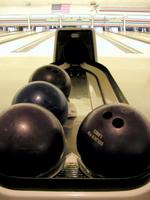What are bowling balls made of?
 Despite my fondness for chucking one down the gutter, I had no idea what mysterious material goes into a bowling ball. A Google search on "bowling ball made of" led me to an enlightening article from the Complete Bowling Index web site. The article summarized the recent history of bowling-ball material.
Despite my fondness for chucking one down the gutter, I had no idea what mysterious material goes into a bowling ball. A Google search on "bowling ball made of" led me to an enlightening article from the Complete Bowling Index web site. The article summarized the recent history of bowling-ball material.In the 1960s, hard rubber balls were king.
Polyester balls stole the scene in the '70s. (Most of the "house balls" in your local bowling alley are of the polyester variety.)
The '80s saw the dawn of the urethane ball.
Urethane balls matured in the early '90s with the introduction of reactive urethane.
I then searched on "reactive urethane," hoping for more information about this new breed of ball, and uncovered the FAQ page of the J & J Bowling Supply web site.
As the site informed us, the innovations didn't end with reactive urethane. The newest material is proactive urethane, which gives the ball a "fuzzy" feel and imnproves traction, "sort of like an all-weather tire does on the motorway."
Receive post updates by Email



























 Add my feed to your Rss
Add my feed to your Rss
